Metal Roofs: Complete Guide to Modern Roofing Solutions
Metal roofing has transformed from a primarily commercial application to one of the most sought-after residential roofing options. With superior performance characteristics compared to traditional materials like asphalt shingles, wood shakes, and clay tiles, metal roofs offer homeowners a compelling combination of durability, energy efficiency, and aesthetic appeal that continues to drive their growing popularity across diverse climates and architectural styles.

Advantages of Metal Roofing Over Traditional Roofing Materials
Metal roofing systems provide significant advantages when compared to conventional roofing materials. Unlike asphalt shingles that typically last 15-25 years, metal roofs can endure 40-70 years with minimal maintenance. They resist common roofing problems such as cracking, warping, and granule loss that plague traditional materials.
Weather resistance represents another crucial advantage. Metal roofs withstand extreme conditions including heavy snow loads, high winds up to 140 mph, and impact from hail. They’re also fire-resistant, earning Class A fire ratings, while materials like wood shakes pose fire hazards. Additionally, metal roofing reflects solar heat rather than absorbing it like dark asphalt shingles, contributing to improved home comfort and reduced cooling costs.
Weight considerations favor metal roofing as well. Most metal roofing systems weigh 50-150 pounds per square compared to concrete tiles at 750-900 pounds per square, reducing structural stress on buildings and potentially eliminating the need for additional framing reinforcement.
Long-term Durability and Maintenance of Metal Roofs
The long-term durability and maintenance requirements of metal roofs make them exceptionally cost-effective over their lifespan. Properly installed metal roofing systems require minimal maintenance beyond periodic inspections and basic cleaning. Most manufacturers offer warranties ranging from 20-50 years, with many premium systems featuring lifetime warranties on materials.
Maintenance typically involves annual inspections to check fasteners, seams, and flashing, along with clearing debris from gutters and roof valleys. Unlike traditional roofing that may require frequent repairs or replacement of damaged sections, metal roofs maintain their integrity through decades of service.
The durability stems from advanced coating systems that protect against corrosion, UV degradation, and color fading. Modern metal roofing features multi-layer protective coatings including galvanization, primer layers, and weather-resistant topcoats that preserve both appearance and structural integrity throughout the roof’s service life.
How Metal Roofing Improves Energy Efficiency in Homes
Metal roofing significantly improves energy efficiency through its reflective properties and thermal performance characteristics. Cool metal roofing systems can reflect 25-95% of solar energy, depending on the color and coating system, compared to traditional asphalt shingles that typically reflect only 5-25%.
This solar reflectance translates to measurable energy savings. Homeowners often experience 10-25% reductions in cooling costs during summer months. The Energy Star program recognizes qualifying metal roofing products that meet specific reflectance and thermal emittance standards, making them eligible for energy efficiency tax credits and utility rebates in many areas.
Metal roofing also facilitates better insulation installation. The dimensional stability of metal panels allows for consistent insulation placement without the sagging or compression issues common with other roofing materials. Some metal roofing systems incorporate integrated thermal breaks that further enhance energy performance by reducing thermal bridging.
Types of Metal Roofing Materials and Their Unique Benefits
Several types of metal roofing materials offer distinct advantages for different applications and budgets. Steel roofing, the most common option, provides excellent strength-to-weight ratios and affordability. Galvanized steel features zinc coating for corrosion protection, while Galvalume steel combines zinc and aluminum for enhanced durability.
Aluminum roofing excels in coastal environments due to its natural corrosion resistance and lightweight properties. Though more expensive than steel, aluminum never rusts and maintains its appearance longer in salt-air environments.
Copper roofing represents the premium option, offering exceptional longevity and distinctive aesthetic appeal. Copper naturally develops a protective patina over time, creating the characteristic green appearance seen on historic buildings. While copper requires significant upfront investment, its 100+ year lifespan and minimal maintenance needs provide exceptional long-term value.
Zinc roofing, popular in European markets, combines durability with self-healing properties. Minor scratches in zinc surfaces naturally heal through oxidation, maintaining the roof’s protective integrity and appearance.
| Material Type | Cost Range per Square Foot | Expected Lifespan | Key Benefits |
|---|---|---|---|
| Galvanized Steel | $7-12 | 40-60 years | Affordable, strong, widely available |
| Galvalume Steel | $8-14 | 50-70 years | Superior corrosion resistance |
| Aluminum | $9-16 | 50-75 years | Lightweight, coastal-friendly |
| Copper | $15-25 | 100+ years | Premium aesthetics, self-protecting |
| Zinc | $12-20 | 80-100 years | Self-healing, distinctive appearance |
Prices, rates, or cost estimates mentioned in this article are based on the latest available information but may change over time. Independent research is advised before making financial decisions.
What Homeowners Should Consider Before Installing a Metal Roof
Homeowners should evaluate several key factors before installing a metal roof. Local building codes and HOA regulations may restrict certain metal roofing styles or colors, particularly in historic districts or planned communities. Researching these requirements early prevents costly modifications or compliance issues.
Budget considerations extend beyond material costs to include installation complexity, structural modifications, and long-term maintenance savings. While metal roofing requires higher upfront investment, the extended lifespan and reduced maintenance often result in lower total cost of ownership.
Climate factors influence material selection and installation requirements. Areas with extreme temperature fluctuations need expansion joints and proper fastening systems to accommodate thermal movement. Regions with heavy snow loads may require specific panel profiles and structural considerations.
Professional installation proves crucial for metal roofing performance. Qualified contractors understand proper fastening techniques, thermal expansion accommodation, and weatherproofing details that ensure long-term success. Obtaining multiple quotes from certified metal roofing contractors helps ensure competitive pricing and proper installation practices.
Metal roofing represents a significant advancement in residential roofing technology, offering superior durability, energy efficiency, and aesthetic options compared to traditional materials. While requiring higher initial investment, the combination of extended lifespan, minimal maintenance requirements, and energy savings makes metal roofing an increasingly attractive option for homeowners seeking long-term value and performance from their roofing investment.




